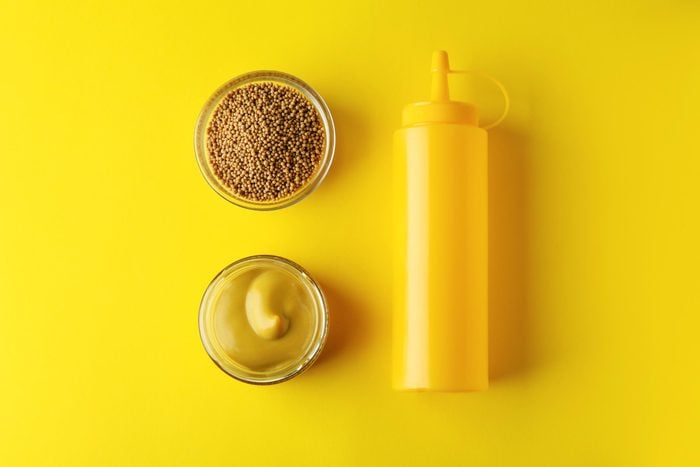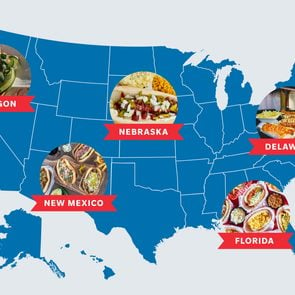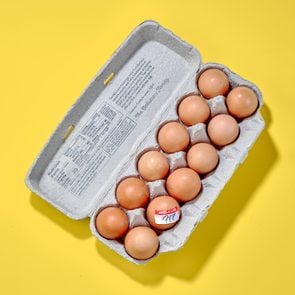What Is Prepared Mustard, Exactly?
Updated: Sep. 06, 2023

It wouldn't be grilling season without this zesty, tangy, sometimes spicy condiment. But what is prepared mustard—and can you make it at home?
You love it on hot dogs. You love it on the best burgers in America. And truly, grilling season wouldn’t be the same without it. We’re talking, of course, about mustard. We all know it as an essential American condiment (and ketchup‘s best buddy), but what is prepared mustard, exactly?
More than 286 million Americans use mustard every year, according to Statista, and while there’s not one single type of prepared mustard, the entire condiment category has fans. “I love mustard because it can be so complex,” says Nancy Longo, chef and owner of Baltimore-based Pierpoint Restaurant. “It can take on flavors like horseradish, black pepper, caramelized onions, roast pepper, lemon, sherry vinegar, curries—the list is practically endless.” Here’s everything you need to know about prepared mustard.
Get Reader’s Digest’s Read Up newsletter for more food facts, humor, cleaning, travel, tech and fun facts all week long.
What is prepared mustard?
Prepared mustard is simply the ready-to-use condiment you see in grocery store aisles (and your very organized pantry). It begins with the seeds of the mustard plant, of which there are three varieties:
- White mustard seeds: Relatively mild and used to make yellow mustard
- Brown mustard seeds: More pungent and used to make spicy brown mustard
- Black mustard seeds: Sharp and spicy and used to make Dijon mustard
To make prepared mustard, these seeds are either left whole or finely ground into a powder, and then mixed with water, vinegar, salt and other seasonings to form a paste. As it sits, the flavors mature and mellow out, melding together into something tangy and slightly spicy. Prepared mustard is packed with concentrated flavor, so a little bit goes a long way. Plus, it has a pretty long shelf life.
What are the types of prepared mustard?
There are many types of prepared mustard found around the world, but these are the most popular and the ones you’ll most likely find in your local supermarket.
Yellow mustard
The most popular type of prepared mustard in the U.S. is yellow mustard, which has a mild, tangy flavor that goes perfectly with hot dogs, hamburgers and sandwiches of all sorts. And it has quite a history: Just like cotton candy, peanut butter and the ice cream cone, this all-American mustard made its debut at the 1904 St. Louis World’s Fair. How’s that for a fun food fact?
Dijon mustard
This mustard originated in the French city of Dijon, and like many French dishes, it gets much of its distinct flavor from wine. Dijon mustard is normally made from finely ground black mustard seeds (or a mixture of black and brown) and made into a paste with a generous amount of white wine vinegar. The tangy, slightly spicy flavor of plain Dijon mustard, a popular addition to salad dressings and marinades, is many people’s go-to mustard when making a ham sandwich. (If you’ve never tried it, you must!) But you can also find many variations of this prepared mustard that feature herbs, spices, garlic or other flavors.
Whole grain mustard
This type of mustard is, obviously, made with whole grain mustard seeds instead of ground mustard powder. It can be made with yellow, brown or black mustard seeds, or any combination of the three. The flavor of whole grain mustard depends on what type of seeds are used, though it can usually be described as robust. Additionally, this mustard adds a wonderful texture to meats and sandwiches and is a popular addition to cheese and charcuterie boards.
Spicy brown mustard
Popularly found in delis, spicy brown mustard is made from a combination of brown mustard seeds, vinegar, water and spices. Compared with yellow mustard, it has a more intense, spicy flavor. While yellow mustard might be the prepared mustard of choice for ballpark hot dogs, spicy brown mustard is the go-to at many hot dog carts, especially because it pairs so well with sauerkraut.
Honey mustard
Combining the tanginess of mustard with the sweetness of honey, honey mustard is a sauce made by mixing prepared mustard with honey. While yellow mustard is the most popular choice, any mustard can be made into honey mustard. To add more creaminess to homemade honey mustard, mix it with a bit of mayonnaise. Commonly used as a dipping sauce, this sometimes unhealthy condiment can also be used as a glaze for chicken, pork, salmon or vegetables.
What does it mean when a recipe calls for prepared mustard?
When a recipe calls for prepared mustard, it’s referring to the condiment, not mustard seeds or dry mustard powder. If the type of prepared mustard isn’t specified, you can use any savory mustard you have on hand: yellow, brown or Dijon. Just make sure you consider the flavor profile of the mustard you’re using before adding it to your recipe. Since brown and Dijon mustard are stronger than yellow, add slightly less than what’s called for in the recipe, then taste and add the remaining mustard at your discretion.
What is a prepared mustard substitute?
If you’re out of prepared mustard, you can easily make a substitute by mixing two parts dry mustard powder, one part water and one part vinegar together into a smooth paste. Wine and apple cider vinegars are good choices, as is fresh lemon juice.
How to make your own prepared mustard
Even though there’s a countless number of prepared mustards on the market, you might want to try making your own at least once. It’s fun to try and make something that’s usually store bought, and you can get creative with customizing the flavors and textures. Here’s how to make your own prepared mustard:
Ingredients
- 2/3 cup ground mustard powder, or 1/3 cup mustard powder and 1/3 cup whole mustard seeds (any color)
- 1/4 cup water
- 1/3 cup vinegar (such as white wine vinegar, apple cider vinegar or distilled vinegar)
- 1/4 teaspoon garlic power
- 1/4 teaspoon ground turmeric
- 1 teaspoon salt
Directions
- If using whole mustard seeds, roughly smash them in a mortar and pestle, or leave them whole. (This step is all about the texture of your finished mustard, so it’s your choice.)
- Mix the mustard seeds (if using), mustard powder, water, vinegar, garlic powder, turmeric and salt in a bowl. Stir well to combine.
- Taste the mustard for seasoning. Add additional mustard powder, garlic, turmeric, salt or other herbs and spices as you see fit.
- Let the mustard sit for about 10 minutes to thicken slightly, then adjust the consistency to your liking by mixing in additional water or vinegar, one teaspoon at a time.
- Pour the mustard into a clean jar or container. Seal, then let it sit at room temperature for at least 24 hours as the flavors meld. Taste again, and adjust seasonings to your liking.
- Store your homemade mustard in the refrigerator. And good news: While many condiments expire, your mustard can last almost indefinitely. Note that mustard’s flavors will continue to meld and mellow over time, so continue tasting and adjusting before using.
Sources:
- Nancy Longo, chef and owner of Pierpoint Restaurant in Baltimore
- Statista: “U.S. population: Do you use mustard?”



